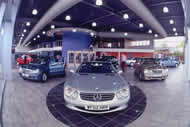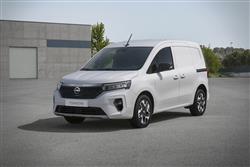Presenter Jonathan Crouch
Click here to view Jonathan's biography.
Used Car Guides
Group Tests
Bespoke Dealer Videos
Home | New Car Road Tests | Vans and Pickups | Nissan Townstar EV
Road Test Video
New Car Road Test | Nissan Townstar EV
TOWN TIME
Nissan's Townstar EV might be the best small battery-powered van you've never heard of. Jonathan Crouch drives it.
Ten Second Review
In full-electric form, Nissan's Townstar small LCV offers all the attributes of an electric Renault Kangoo or Mercedes Citan van, but with a longer five year warranty. Which makes it a strong contender.
Background
It's almost forgotten now that Nissan were amongst the innovators in the field of electric vans. Think of a trend-setting small full-battery-powered LCV and it's the Renault Kangoo Z.E. of 2011 that tends to spring to mind. But Renault's partner Nissan used the same drivetrain in an e-NV200 model that appeared shortly afterwards and sold spectacularly for the Japanese brand.
That model's replacement was this contender, Nissan's Townstar EV, a far more modern and usable take on what a small electric van should be. Like its predecessor, it shares all its drive technology with the electric Renault Kangoo, but this time round, that technology allows for a far greater driving range, swifter performance and faster charging. Sounds promising. To find our more, you'll need the usual complete Car and Driving Road Test.
Driving Experience
The Townstar's EV powertrain is lifted straight from the Renault Kangoo E-Tech (and the Mercedes eCitan). Which means you get a 45kWh battery powered by an electric motor producing 122PS and 245Nm of torque. When fully charged, this variant can offer up to 183 miles of range. That's an improvement of around 45% over the old e-NV200. The electric Townstar combines intelligent energy management and effective battery thermal cooling in one package, but bear in mind that you've to engage a rather restrictive 'Eco' mode to get close to achieving the quoted range.
In terms of ride quality, this EV Townstar fares a little better than its combustion counterpart, thanks to the weight of the battery pack mounted beneath this van's CMF-CD platform. That also helps handling around the twisty stuff, where this Nissan feels a little more engaging to punt around than its Stellantis Group rivals. Impressively, the braked towing weight figure (1,500kgs) isn't affected by a switch to this EV powertrain.
The Townstar EV has three provided levels of selectable regenerative braking: you knock the gear lever to the right, then move it up and down to move between the settings, 'B2' being the default one. On the highway, you should shift the big gear selector into the 'B1' 'Sailing' setting, which limits energy harvesting to the minimum for unimpeded cruising. In town meanwhile, you'd activate the fiercest 'B3' 'Brake' setting, which slows the van noticeably off-throttle, though not to the extent you'd get from the 'e-Pedal' system championed by some of Nissan's other electrified models. As with the petrol Townstar, there's also an Eco mode to stifle the throttle and maximise range, but in the EV version, it muffles power output more considerably, reducing it by half to just 60hp, so you won't really want to engage it outside the city limits unless you really are running low on charge.
As for refinement, well there's a bit of wind noise at higher speeds and some electric motor whine under hard acceleration, but overall, it's a little better than rival Vauxhall, Peugeot, Citroen and Fiat EV van models. The cabin's a little less boomy than it is with those rivals, presumably because of extra sound-deadening. At town speeds, the legislation-required artificial sound effects kick in to warn unwary or disabled pedestrians of your approach: Nissan has installed the 'Canto' sound it developed for its passenger cars, which pulses more loudly when this Townstar is reversing.
Design and Build
Downtown, this little Nissan should fit right in, its sharp front end looks reflecting the aesthetic cues of the company's Ariya full-electric car. This full-electric Townstar looks a little different to the petrol Townstar variant because it merely has a front end blanking plate; the combustion model requires a radiator grille to admit cooling air to its 1.3-litre petrol engine. With this EV, that blanking plate is flanked by signature LED headlamps and an aerodynamic front shield incorporating a smart 'Kumiko' pattern and a restyled version of Nissan's usual 'V-Motion' front-end theme, along with daytime running lights.
Take a seat inside and it feels pretty car-like, with a basic dashboard design that's user-friendly, though has lots of hard plastics, broken up by a faux-aluminium dashboard panel. A key change over the old NV250 model is that you can replace this single passenger seat with an optional two-person bench. Digital instruments haven't reached the combustion part of the van segment yet, but you get them on this EV version, though only with this top-spec 'Tekna+' trim level, one that hardly any Townstar folk will choose. This features a 10-inch configurable screen: other versions of this Nissan have analogue gauges separated by a 4.2-inch TFT colour display.
The central infotainment monitor is an 8-inch 'Colour Touchscreen Audio System' set-up straight from the Renault parts bin and fitted to all Townstars bar those with the meanest standard of trim. Only the top two spec levels though, get this display fitted out with navigation. Though it's disappointing that there's no provision for a flap into the cargo area, you'll be impressed by the multitude of cab stowage areas, which include an upper shelf, big door bins and a useful lidded cubby built into the instrument binnacle top.
Market and Model
You might be a bit shocked at the price premium this EV version of the Townstar demands over its petrol-powered equivalent - it's about £10,000, which at the time of our test in Autumn 2023 meant a starting price for the Townstar EV of around £30,000, after deduction of the government's £2,500 Plug-in Van Grant. As with the petrol model, there are two Townstar panel van body lengths - L1 and L2. And four trim levels - 'Visia', 'Acenta', 'Tekna' and 'Tekna+'. The asking figures range up to around £35,000 (after grant deduction) for the top 'Tekna+' variant.
You can get those prices down further by including the TFL Scrappage Scheme grant in your calculations. Add that to the Government Plug-in Van Grant and you could take a total of £12,000 off the cost of a Townstar EV, which in theory would bring the price down to only just above the figure required for the petrol variant.
With all versions of the EV model, the brand includes a Mode 2 10amp domestic charging cable, plus another cable (of the Mode 3 Type 2 variety) to go into a garage wallbox or public charger. The Townstar EV also comes with a heat pump so that the passenger compartment can be warmed using ambient air, reducing energy drain from the climate system in colder conditions. And there's a bespoke 'NissanConnect Services' app for the EV version which allows you to remotely set charging times (to benefit from cheaper off-peak tariffs) or pre-heat or pre-cool the cabin (so you don't have to use climate fan energy doing so once you start off). Bear in mind that a 'Visia'-trimmed Townstar EV can only charge up to 11kW: with the plusher trim levels, you'll be able to charge at up to 22kW, so consider that before you make too many decisions about saving money on trim spec.
Practicalities & Costs
As is now usual with electric vans, there are no practicality downsides in choosing a full battery drivetrain. There are two Townstar body lengths, short L1 and long wheelbase L2. The L1 can carry up to 3.3m3 (quite a lot less than the 4.2m3 of its e-NV200 predecessor), but if you stretch to the L2 Townstar model, you can boost that to 4.3m3 of load space. You only get a second side sliding door on the 'L1' variant if you avoid base 'Visia' trim.
Both body shapes can squeeze in a pair of standard Euro pallets thanks to the generous 1,248mm width between the wheel arches that all Townstars share - it's 1,570mm from wall to wall. This rear entrance aperture is 1,115mm tall by 1,256mm wide (narrowing to 1,196mm just above the tail lights). The loading length is 1,810mm in the 'L1' version - or 2,230mm with the 'L2' body shape (which has a slightly lower loading sill height of 613mm). As usual in this class, there's no option of a high-roof body shape to extend the ceiling height, which is 1,215mm with the 'L1' version and 1,229mm with the 'L2'.
As for the cargo area payload, well if that's important to you, then you might want to think twice about this EV electric version because it's slightly restricted there - with the 'L1' standard body shape to 500kgs (compared to 689kgs in the combustion version). An 'L2' long wheelbase Townstar EV could carry up to 702kgs (compared to up to 770kg in the combustion version). Those restrictions are due to the extra 200kgs the EV model carries about courtesy of its drive battery, but that's not really an excuse as rival Peugeot, Citroen, Vauxhall and Fiat Stellantis Group small EV vans can take around 200kgs more in their short wheelbase forms.
On to running costs. We gave you this Townstar EV's driving range figure in our 'Driving' section - 183 miles - which is vastly more than was possible from the previous e-NV200 model. What about charging? Well be aware that with base 'Visia' trim, this Townstar EV can only charge up to a meagre 11kW speed. From a home wallbox or public charger, that means a full charge will take just under four hours - or 7 hours with a more common 7.4kW garage wallbox. Most Townstar EVs though, will be purchased with one of the three plusher trim levels available, which will allow 22kW AC charging capability (which at the time of this test you couldn't get with rival Stellantis Group electric vans) and 80kW DC rapid charging (a little less than the 100kW Stellantis system). That'll mean that using a 22kW charger, you'll be able to fully replenish the 45kWh battery in around 2 hours, while a 0-80% top-up from the right DC public rapid charger will take just 39 minutes.
You'll need to bear in mind that the price gap between petrol and electricity has narrowed considerably in recent times and as a result, if most of your charging is of the rapid DC public kind, you might find that the savings you'll get in opting for an EV van aren't quite as great as you might have initially expected. All Townstar EVs come with two charging cables, one for home wallboxes and public charging points, the other for a standard 2.3kW domestic plug socket (which will require over 13 hours of charging time). All Townstar EVs also come fitted with a heat pump, which will preserve battery life in really cold conditions.
This van has a five year / 100,000 mile warranty (much better than the three year deal you'd get with this model's Renault and Mercedes clones). And its battery has a separate eight year 100,000 mile warranty.
Summary
The Nissan Townstar EV is the small electrically powered van you may have left off your wish list if you're seeking a compact battery-powered LCV. Which could be a mistake because there's very little that any of its competitors can offer that this little Nissan can't match. And it'll do so with the added peace of mind of a 5 year warranty that's longer than virtually all its rivals. The brand needs to address issues with short wheelbase body style payload and base-spec charging speed though.
Overall though, it's certainly a big step forward from the old e-NV200 and if your business ran one of those, once you've got used to the fact that the bigger battery in this Townstar takes longer to charge, we think you'll like just about everything else about it. Apart perhaps from the price, which is a bit of a step up - but that's the case with most rivals too. A Townstar offers a thoughtful customer's alternative to any of them.
Related Road Tests
Browse the other models
Currently viewing New Car Road Tests, switch to Used Car Road Tests
Select a model to browse through the videos.





.jpg)
.jpg)
.jpg)
.jpg)
white.jpg)